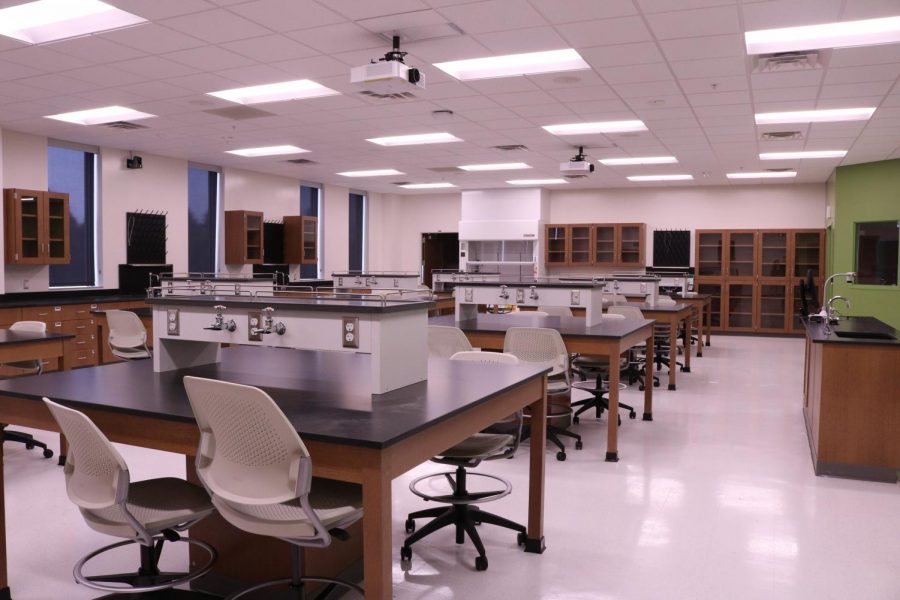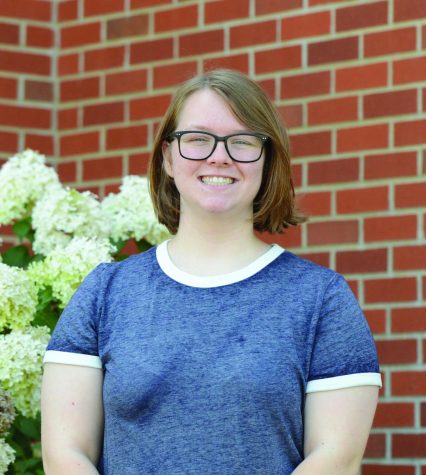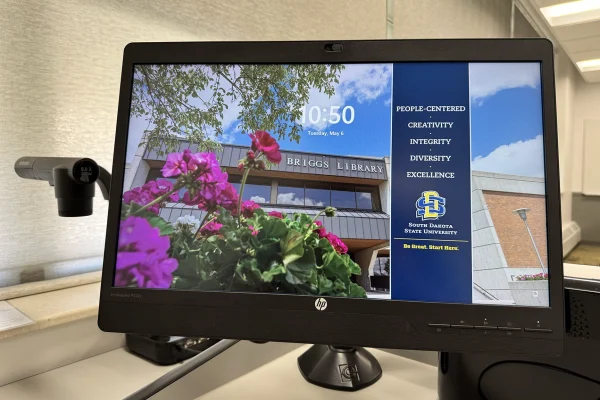$46 million Raven Precision Ag Center opens to students
August 31, 2021
With almost two weeks of classes underway for the fall semester, students have probably noticed the newest addition to South Dakota State University is open and already hosting classes.
“Other than students getting lost … everything has gone extremely well for the first week of class,” David Wright, head of the Department of Agronomy, Horticulture and Plant Science, said.
Wright’s department, along with the agricultural and biosystems department, will now be housed in the Raven Precision Agriculture Center. These departments used to be in Berg Agricultural Hall and the Agricultural Engineering Building, respectively.
Some classes being held there this semester include crop and soils teaching labs, a freshman seminar, precision ag data mapping class and all ag engineering classes.
The facility covers roughly 130,000 square feet with 450 classroom seats. Several lab spaces are reserved for soil studies, mechanics and more, and most have windows for students walking by to peer in and observe the classes.
Both departments’ faculty will share common spaces, allowing for more interdisciplinary collaboration.
Students can relax in special study areas along the main walkway, complete with whiteboards, LED monitors that can be hooked up to laptops and plenty of table space for shared learning.
“When we were in the process of designing this building, we really wanted it to be a very student-centered design,” Wright said. “We have areas throughout the building that are unique to this building and designed to enhance student learning and student creativity.”
Some of the most unique features of the building are the mid and high bays, designed with raised ceilings and large garage-style doors so large-scale machinery can be brought in for hands-on demonstrations.
Other rooms include graduate student areas, conference rooms and administration offices.
Most importantly, the Precision Ag Center isn’t only for precision ag students: with one classroom in the building scheduled by the university, students of any major could potentially have classes held in the new building.
SDSU’s newest addition has been in the works since 2018, when plans were first drawn up for the facility. Construction began shortly after during the spring of 2019.
The whole structure cost about $46 million, with donations coming in from state legislation, precision ag and bioprocessing corporations and private donors.
“We couldn’t have done this without the support of the state legislature,” Wright said. “They contributed $22 million toward this building, and we had a very long list of donors that contributed to the building, all the way from farmer-led organizations to corporate businesses.”
Students like Parker Aase, a senior precision ag major, are excited for the opportunities the new building will provide.
“The new Raven Precision Ag building is a great leap forward for SDSU,” he said. “We are already a class above others in our field, but this will make us even higher of a caliber.”
Hadley Stiefvater, an animal science and ag leadership major who has classes in the new building, was impressed by the scope of the facility, as well.
“I think it’s pretty phenomenal how well built this building is and how there’s so many unique opportunities for students in here,” she said. “Like miniature classroom study rooms, being able to do homework in various locations around the building, but also some pretty awesome lab equipment and unique opportunities that many students wouldn’t get.”
As one of the leading schools in the country when it comes to precision agriculture studies, SDSU gains several benefits with the ag center’s construction.
Wright says the addition of this building will open new pathways in research related to precision ag. Pest management studies have been looking into using new technology for research in crop health.
“Right now, we’re looking at the use of drones to apply synthetic chemicals, so fungicide,” Wright said. “It would identify diseases of importance; it could identify insects that are predatory.”
Not only that, but it will help keep students and faculty one step ahead of the ever-changing nature of the major.
The technological and learning opportunities provided with the new space will allow for new minors and specializations, as well as adapted coursework, to be added as necessary.
“We’re continually modernizing the courses, because agriculture itself is changing very, very quickly, so we can no longer teach the courses that we taught 20 years ago, certainly not even 10 years ago,” Wright said. “So, we are going through an effort to make sure all of our courses that students take reflect the technology and modern thinking processes of modern agriculture today.”
And when it comes to entering the job force after college, SDSU students are now at an even greater advantage with the facility.
Biochemists and biophysicists are expected to be in higher demand in future years to “do basic research that increases scientific knowledge and to research and develop biological products and processes that improve people’s lives,” according to the U.S. Bureau of Labor Statistics.
Companies like POET, a leader in the bioproducts industry with locations nationwide, including Sioux Falls, will also be looking to hire students like precision ag majors in the coming years.
“There is a need for new techniques, tools and applications in agriculture, which will result in new careers and specialties that this program [precision ag] seeks to fill,” Jessica Sexe, director of public relations for POET, said. “We are excited to help fill that need right here in South Dakota through the Precision Agriculture Center.”
SDSU has already cemented global recognition in precision agriculture because of the uniqueness of the program.
“Larger universities aren’t able to offer a program like this because they’re not nimble enough, where SDSU, one of the reasons our graduates are so sought after, is we are nimble enough to identify the evolving needs of the ag industry and respond to it in our course curriculums,” he said.
That’s good news for companies like POET, who work hand in hand with the newest agricultural developments.
“At 20% of the state’s economic activity and $20.9 billion annual impact, agriculture is South Dakota’s largest industry,” Sexe said. “When agriculture prospers, the biofuels industry grows, resulting in a mutually beneficial cycle that in turn supports the larger economy.”
To celebrate the completion of the Precision Ag Center, a ribbon cutting ceremony will be held Sept. 11. A research day is also being planned.
Overall, Wright says he has most enjoyed seeing the impact this building has had on both current and future students.
“The most fun we’ve had is parents and prospective students come through,” Wright said. “Just to see the smiles on their faces, the amazement, that’s been fun to watch.”
Related majors
and minors
Majors
Agronomy
Agricultural Systems Technology
Minors
Agricultural Business
Agronomy
Data Science
Mechatronics Technology
Sustainability























